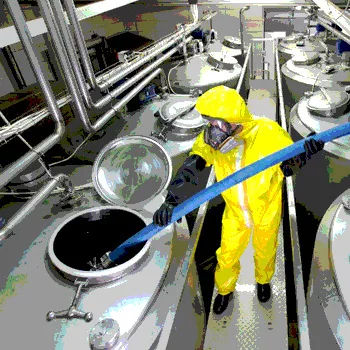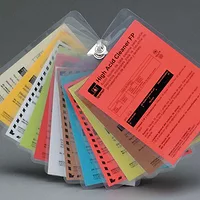Five Sanitation Tips for Getting Sanitation Right in 2016

For consumers and manufacturers, product production speed can often take precedent over one of the most important factors in running an operation: sanitation.
Product recalls resulting from manufacturing errors in sanitation often garner national headlines and cause widespread mistrust and panic among consumers.
For example, the Texas-based ice cream manufacturer Blue Bell Creameries is still facing public scrutiny for their Listeria-related recalls this past summer. On January 11, the company had to release a statement claiming their ice cream is safe to eat, despite recent health concerns.
Making changes to increase efficiency and sanitation have yielded dramatic improvements for manufacturers. A large U.S. food manufacturer installed the system recommended in five of their plants and quickly cut costs while boosting productivity.
One of the plants was able to repatriate production, outsourced to a co-manufacturer at a savings of approximately $500,000.
Another replaced its entire 50+-person sanitation crew with a subcontract cleaning crew, reducing its labor cost from $22 to $11.47 an hour, while at the same time increasing the work effectiveness of the crew and performing 15 percent more sanitation work within the same time frame.
It is without a doubt that maintaining your operation’s sanitation will work towards your benefit in numerous ways. To start off 2016 strong, here are five essential tips to keep in mind:
1. Know your problem areas before you make changes
Tackling your sanitation needs is not always an easy feat. The best way to approach improving sanitation in your plant is to conduct a detailed study of the current processes to define the areas that need work. This may include equipment effectiveness, supervisory staff and materials used.
Many times, the root cause of sanitation problems can get overlooked or not properly addressed, because the time and detailed study of the current process are not closely examined. Keep in mind that you may have to hire outside help to get a rigorous study properly completed. It is not unusual to discover at least 30 percent of non-valued time within the existing process, mainly due to poor planning, poor coordination or the use of overly cumbersome methods.
Once you pinpoint the problem areas, the real fun can begin. An effective study will help you determine your goals and plans to streamline your operation and create a standardized method for running everything smoothly.
2. Make sanitation a priority, not an option
When sanitation gets put on the back burner, it often ends up in flames. It is so easy to ignore sanitation issues until it is too late to do anything but clean up a huge, avoidable mess. A crucial component of successful sanitation practices is having a management mind set. Sanitation is a critical part of the business and must be managed, controlled and executed with the same level of attention to that of the production and maintenance operations.
Instead of making sanitation a troublesome necessity, turn it into a competitive advantage by focusing on overall equipment effectiveness (OEE). Your operation will see an increase in capacity without investment or additional resources, and it does not need to be overly difficult or expensive.
However, OEE management does require detailed process analysis, process rethinking, reconstructing of resource assignments and installation of management control and reporting systems. When equipment is scheduled to run, it is running at the correct rate, using the right number of resources and at the right level of quality. This will not only boost the efficiency of your operation but the safety and quality of it as well.
3. Do what’s best for long-term success
While not investing in sanitation may save you a little money in the short run, neglecting it can cause exponentially larger costs down the road, including elevated food scrap, equipment reliability failures, excessive non-value adding to production time, expensive recalls, remediation costs, potential legal liability, stricter federal regulation and destroyed consumer trust.
Save yourself from unexpected disaster and plan ahead. This draws back to having a strong OEE management plan in place as well as creating a culture within the company that stresses the importance of sanitation. It only takes one person to put your whole operation at risk.
Again, this goes hand in hand with making sanitation a priority. Sanitation operations have sometimes been viewed as being secondary in importance, something that is done when orders are completed and finished, and is customarily executed on off-shifts or weekends. This typically means that there is limited management presence or oversight, and the work is executed in an ad hoc, poorly controlled way. This is a mistake.
Clear expectations, clear roles and responsibilities and measured performance are the hallmarks of well-executed operations and an effective way to make sanitation a priority.
4. Adopt LEAN techniques
LEAN is an older, but proven way to reduce waste and up your efficiency. Using LEAN will allow you focus in on three essential areas: elimination of waste, reduction in variability and reduction of inflexibility. When these factors come together, work can be completed in a standardized, efficient and sanitary manner.
Fully adopting LEAN approaches in your operations will involve:
• Determining the current situation
• Reviewing protocols and testing
• Assessing labor agreements
• Standardizing crew, tools, equipment and materials
• Planning and creating a visual board
5. Make it right
We live in an era where corporate responsibility and branding has become increasingly important, not just to distinguish one’s brand, but to garner positive awareness. Manufacturing isn’t only about quantity; it involves ensuring a level of quality that builds consumer loyalty and efficiency.
When your product potentially poses risk for the consumer, it also poses a danger to your business and its success. It should also appeal to a higher code of ethics to ensure the products you are making and selling will not pose a risk on your employees or your consumers.
Remember, you don’t have to risk using unsanitary methods for the sake of saving money or increasing efficiency. In fact, sanitation and efficiency are easily attainable when they are brought together in a strategic plan. Putting in the time and dedication to create an effective sanitation plan will help you avoid negative consequences and bring you to the top of your game.
Tim Tancred is a partner with Myrtle Consulting Group, a value-based operations consulting firm that drives improved supply chain performance, particularly in manufacturing and distribution.
Looking for quick answers on food safety topics?
Try Ask FSM, our new smart AI search tool.
Ask FSM →








